EDF Bundle
How Does EDF Navigate the Global Energy Landscape?
EDF (Électricité de France), a French energy giant, is a pivotal player in the global energy market, primarily owned by the French state. As one of the world's largest electricity producers, EDF company significantly influences electricity generation, distribution, and supply. Its strategic importance extends beyond mere utility provision, making it a key asset for France and a major contributor to the European energy mix.
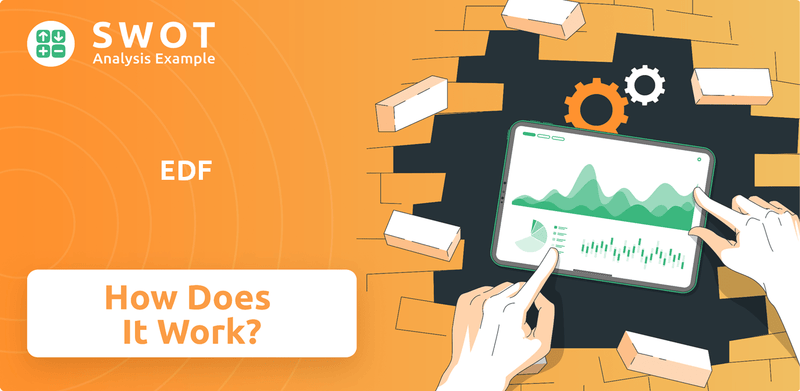
This exploration into EDF will dissect its core operations, revenue streams, and strategic initiatives. We'll examine its diverse portfolio, including nuclear power plants and renewable energy projects, and assess its competitive standing. Furthermore, we'll analyze the risks EDF faces and how it adapts to the dynamic energy market. For a deeper dive into its strategic position, consider the EDF SWOT Analysis.
What Are the Key Operations Driving EDF’s Success?
The core operations of the EDF company involve managing the entire electricity value chain, from generation to supply. The company's primary value comes from its diverse electricity generation assets, with nuclear power playing a central role, especially in France. It also includes hydroelectric plants, thermal generation, and a growing presence in renewable energy sources like wind and solar. This comprehensive approach allows EDF energy to serve a wide range of customers, including residential, industrial, and commercial clients across several international markets.
Operational processes at EDF are highly integrated and complex, ensuring the reliable flow of electricity. This includes the meticulous management of power plants, the efficient transmission and distribution of electricity through subsidiaries, and global sourcing of fuel. Technology development is crucial for optimizing plant performance and advancing renewable energy solutions. Sales channels include direct customer relationships and online platforms. Customer service is also a critical component for managing accounts and promoting energy efficiency. The company's supply chain involves numerous suppliers for equipment, fuel, and services, alongside strategic partnerships, particularly in renewable energy initiatives.
What sets EDF apart is its deep integration across the entire electricity value chain, combined with its expertise in nuclear technology and large-scale infrastructure management. This comprehensive capability translates into benefits for customers, such as a reliable electricity supply, a diverse energy mix, and innovative energy services aimed at efficiency and sustainability. As of 2024, EDF has been investing heavily in renewable energy projects, aiming to increase its capacity significantly in the coming years. Furthermore, the company has been focusing on enhancing its customer service offerings, including digital tools and personalized energy solutions.
EDF generates electricity from various sources, including nuclear, hydroelectric, thermal, wind, and solar. Nuclear power is a significant part of its portfolio, especially in France. The company is continuously investing in renewable energy projects to diversify its energy mix and reduce carbon emissions. In 2024, EDF's renewable energy capacity increased by approximately 10%, reflecting its commitment to sustainable energy sources.
Transmission and distribution are handled by subsidiaries like RTE and Enedis in France. These networks ensure the reliable delivery of electricity to millions of households and businesses. The company invests heavily in maintaining and upgrading its grid infrastructure to improve efficiency and reliability. In 2024, EDF invested over €2 billion in its distribution networks.
EDF provides customer service through various channels, including direct customer relationships and online platforms. They offer support for account management, inquiries, and energy efficiency programs. Customer satisfaction is a key focus, with continuous efforts to improve service quality. Recent customer satisfaction surveys showed an improvement of 5% in overall satisfaction scores.
EDF forms strategic partnerships to develop new nuclear projects and renewable energy initiatives. These collaborations are vital for expanding its capacity and expertise. These partnerships help EDF stay at the forefront of energy innovation. Recent partnerships have focused on offshore wind projects, with investments exceeding €1 billion.
EDF's operations are characterized by deep integration across the entire electricity value chain, nuclear technology expertise, and large-scale infrastructure management. This comprehensive approach translates into reliable electricity supply and innovative energy services. Understanding the Target Market of EDF is crucial for optimizing its strategies.
- Nuclear power remains a cornerstone of EDF's generation capacity, especially in France.
- Significant investments in renewable energy sources, such as wind and solar, are ongoing.
- Advanced grid infrastructure ensures reliable electricity transmission and distribution.
- Customer service enhancements focus on digital tools and personalized energy solutions.
EDF SWOT Analysis
- Complete SWOT Breakdown
- Fully Customizable
- Editable in Excel & Word
- Professional Formatting
- Investor-Ready Format
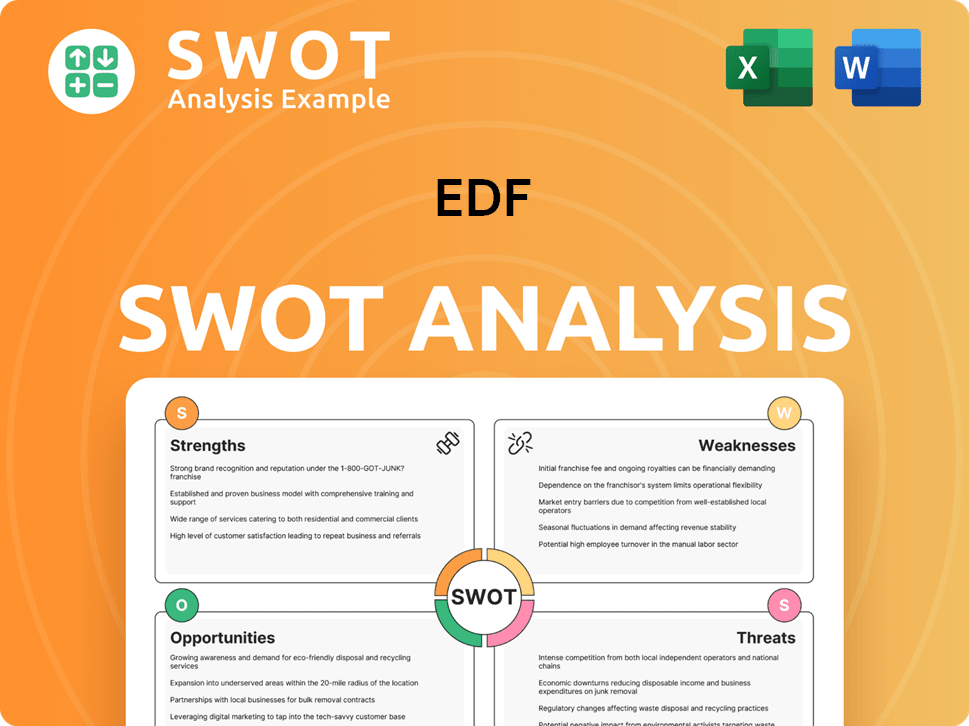
How Does EDF Make Money?
The core of EDF's business revolves around generating and selling electricity, making it a major player in the energy sector. As a vertically integrated energy supplier, EDF manages various aspects of the electricity value chain, from production to distribution. This approach allows EDF to control costs and offer a range of services to its customers.
EDF energy generates revenue primarily through the sale of electricity. This includes sales to residential, commercial, and industrial customers. The company also diversifies its income through energy-related services and operations, such as operating its power plants and managing transmission and distribution networks.
EDF's financial performance showcases its significant scale. In 2023, the company reported total sales of approximately €139.7 billion, emphasizing the substantial revenue generated from its electricity sales operations. This figure reflects the company's extensive reach and its importance in the energy market. For more insights, you can explore the Marketing Strategy of EDF.
EDF employs several strategies to generate revenue and expand its business. Beyond direct electricity sales, the company focuses on energy services and infrastructure. This includes energy efficiency solutions, smart home technologies, and electric vehicle charging infrastructure. Furthermore, EDF actively engages in energy trading to optimize its portfolio and respond to market changes.
- Electricity Sales: The primary revenue source, encompassing sales to residential, industrial, and commercial customers.
- Energy Services: Offering solutions like energy efficiency, smart home technologies, and EV charging.
- Operation and Maintenance: Managing generation assets, especially nuclear power plants.
- Transmission and Distribution: Revenue from regulated subsidiaries managing electricity networks.
- Energy Trading: Optimizing the energy portfolio through market activities.
EDF PESTLE Analysis
- Covers All 6 PESTLE Categories
- No Research Needed – Save Hours of Work
- Built by Experts, Trusted by Consultants
- Instant Download, Ready to Use
- 100% Editable, Fully Customizable
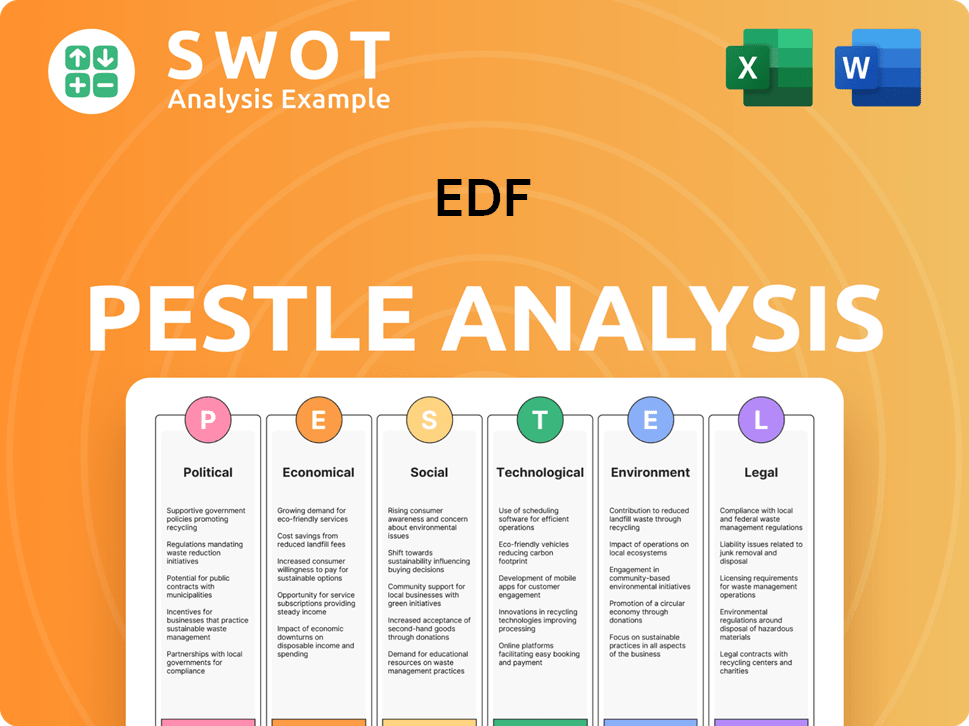
Which Strategic Decisions Have Shaped EDF’s Business Model?
The operational and financial trajectory of the EDF company has been significantly shaped by key milestones and strategic initiatives. A crucial ongoing strategic move is the 'EDF Plan,' announced in April 2023. This plan is designed to address the company's financial challenges and accelerate its transition towards sustainable energy sources. The plan encompasses substantial investments in the maintenance of its nuclear fleet, the development of new nuclear projects, and a strong push into renewable energy.
Another pivotal element in EDF's journey is the continuous development of new nuclear power plants. The Hinkley Point C project in the UK, despite facing cost overruns and delays, represents a major long-term investment in low-carbon electricity generation. The company has also strategically managed its portfolio through asset divestitures and acquisitions to optimize its focus on core competencies.
EDF has faced operational and market challenges, including the need for extensive maintenance on its nuclear fleet, which impacted its electricity output in recent years. In 2022, nuclear output in France reached its lowest level in 30 years due to corrosion issues and planned outages. The company has responded by intensifying maintenance programs and investing in fleet modernization. Regulatory hurdles, particularly concerning electricity price regulation in France, have also presented challenges. To understand more about EDF's strategic direction, consider exploring the Growth Strategy of EDF.
EDF's history is marked by significant milestones, including the development of its nuclear fleet and expansion into renewable energy. The company has consistently adapted to evolving market conditions and technological advancements. The 'EDF Plan' announced in April 2023, is a strategic move to address financial challenges and accelerate the energy transition.
Strategic moves include investments in nuclear fleet maintenance and new builds, as well as a strong push into renewable energy sources. Divestitures and acquisitions have been used to optimize the portfolio and focus on core competencies. EDF is adapting to the growing demand for decarbonized energy and the digitalization of the energy sector.
EDF's competitive advantages stem from its strong brand, technological leadership in nuclear power, economies of scale, and integrated operations. The company's vast generation capacity and extensive infrastructure allow for cost efficiencies. EDF is adapting to new trends by investing in smart grid technologies and innovative customer solutions.
EDF has faced operational challenges, including the need for extensive maintenance on its nuclear fleet, which impacted electricity output. Regulatory hurdles, particularly concerning electricity price regulation in France, have also presented challenges. The company has responded by intensifying maintenance programs and investing in fleet modernization.
EDF's competitive advantages include brand strength, technological leadership in nuclear power, economies of scale, and integrated operations. The company is adapting to new trends by investing in smart grid technologies and renewable energy. The company's integrated operations, from generation to distribution, provide an ecosystem effect that enhances its market position.
- Strong brand recognition and deep roots in France.
- Technological leadership in nuclear power generation.
- Economies of scale derived from vast generation capacity.
- Integrated operations from generation to distribution.
EDF Business Model Canvas
- Complete 9-Block Business Model Canvas
- Effortlessly Communicate Your Business Strategy
- Investor-Ready BMC Format
- 100% Editable and Customizable
- Clear and Structured Layout
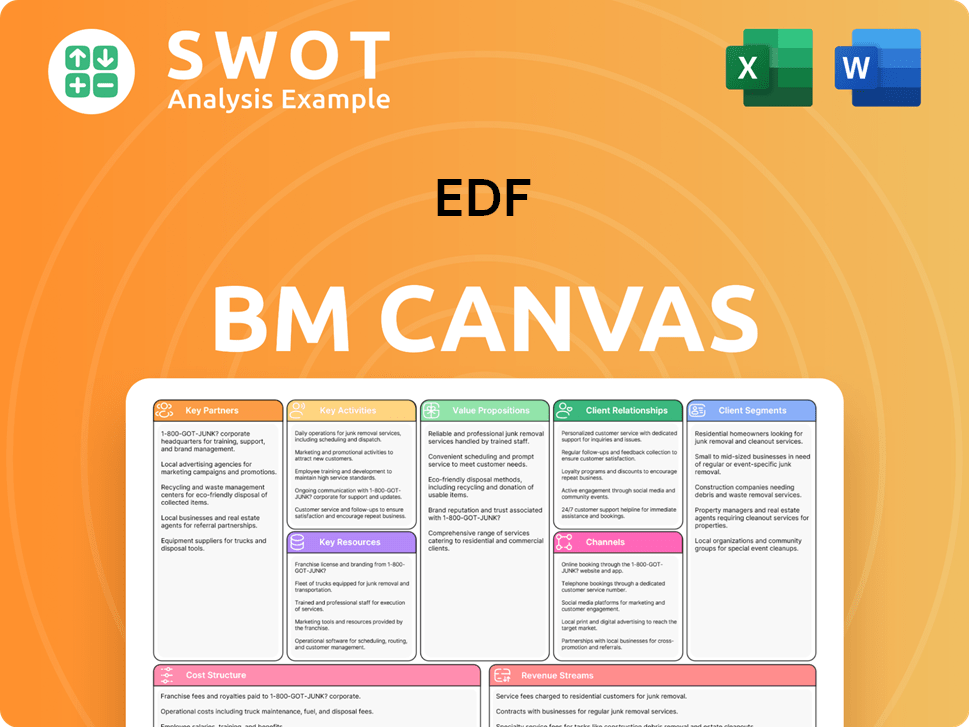
How Is EDF Positioning Itself for Continued Success?
As a leading Electricity provider, EDF, also known as EDF energy, holds a strong position in the French energy market. It is the primary electricity producer and supplier in France, with significant market share across generation, transmission, and distribution. Globally, EDF company ranks among the largest electricity producers, demonstrating its extensive reach.
However, EDF faces challenges in liberalized markets, particularly from new entrants in renewable energy. Customer loyalty remains high in regulated markets, but competition is increasing in other segments. This landscape is influenced by pricing, service quality, and green energy offerings.
EDF is exposed to risks such as regulatory changes, especially concerning nuclear safety and carbon pricing. Competition from renewable energy companies and technological advancements like energy storage pose further challenges. Changing consumer preferences towards sustainable energy solutions are also significant.
EDF's strategic initiatives focus on strengthening its nuclear fleet and accelerating renewable energy deployment. The company is investing in small modular reactors (SMRs) and digital solutions for energy management. EDF aims to leverage its expertise to remain a leading player in the global energy transition, with a goal of carbon neutrality by 2050.
EDF dominates the French energy market. In 2024, EDF generated around 75% of France's electricity. The company faces competition from various sources, including other Energy supplier companies and renewable energy providers. The liberalized market in the UK and other regions has increased competition. For more insights, consider exploring the Competitors Landscape of EDF.
EDF is investing heavily in renewable energy projects, aiming to increase its renewable capacity significantly by 2030. In 2024, EDF reported revenues of over €143 billion. The company's strategic focus includes expanding its renewable energy portfolio, optimizing its nuclear assets, and developing innovative energy services to navigate the energy transition.
EDF faces challenges from regulatory changes and competition. The company must adapt to changing consumer preferences for sustainable energy. Opportunities include expanding renewable energy projects and developing new energy services.
- Regulatory Risks: Changes in nuclear safety regulations and carbon pricing can impact profitability.
- Competition: Increased competition from renewable energy providers and alternative energy services.
- Technological Disruption: Advancements in energy storage and decentralized systems altering business models.
- Consumer Preferences: Growing demand for sustainable and localized energy solutions.
EDF Porter's Five Forces Analysis
- Covers All 5 Competitive Forces in Detail
- Structured for Consultants, Students, and Founders
- 100% Editable in Microsoft Word & Excel
- Instant Digital Download – Use Immediately
- Compatible with Mac & PC – Fully Unlocked
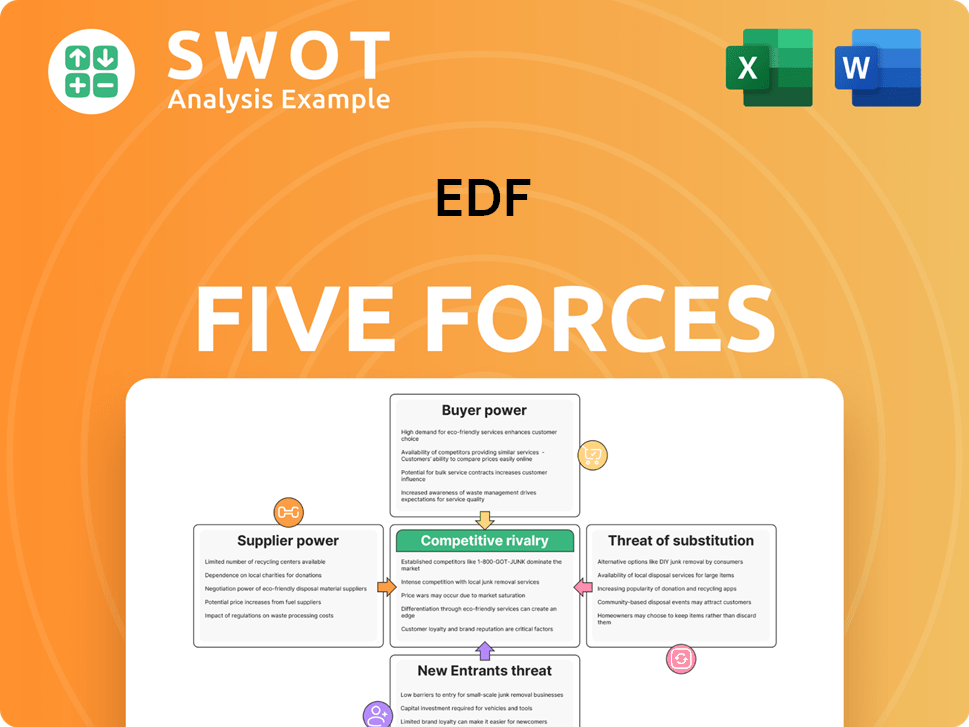
Related Blogs
- What are Mission Vision & Core Values of EDF Company?
- What is Competitive Landscape of EDF Company?
- What is Growth Strategy and Future Prospects of EDF Company?
- What is Sales and Marketing Strategy of EDF Company?
- What is Brief History of EDF Company?
- Who Owns EDF Company?
- What is Customer Demographics and Target Market of EDF Company?
Disclaimer
All information, articles, and product details provided on this website are for general informational and educational purposes only. We do not claim any ownership over, nor do we intend to infringe upon, any trademarks, copyrights, logos, brand names, or other intellectual property mentioned or depicted on this site. Such intellectual property remains the property of its respective owners, and any references here are made solely for identification or informational purposes, without implying any affiliation, endorsement, or partnership.
We make no representations or warranties, express or implied, regarding the accuracy, completeness, or suitability of any content or products presented. Nothing on this website should be construed as legal, tax, investment, financial, medical, or other professional advice. In addition, no part of this site—including articles or product references—constitutes a solicitation, recommendation, endorsement, advertisement, or offer to buy or sell any securities, franchises, or other financial instruments, particularly in jurisdictions where such activity would be unlawful.
All content is of a general nature and may not address the specific circumstances of any individual or entity. It is not a substitute for professional advice or services. Any actions you take based on the information provided here are strictly at your own risk. You accept full responsibility for any decisions or outcomes arising from your use of this website and agree to release us from any liability in connection with your use of, or reliance upon, the content or products found herein.